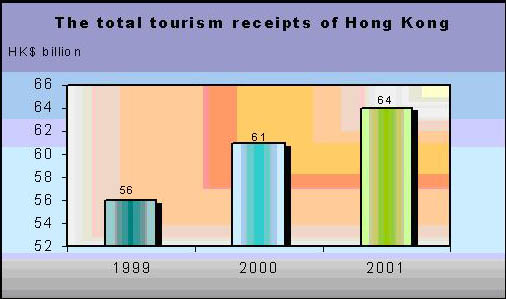.jpg)
.jpg)
Lighting up Hong Kong
City of Life
By Carol Wong and Cherry Chan
On 22 December 2001, the press of a button sparked off a blaze of Christmas lights that broke the darkness of night in Hong Kong.
The “CLP Lights Up Hong Kong” campaign was the first event of a two-year effort organized by the Tourism Board. A ceremony took place on the waterfront in Tsim Sha Tsui East with the Aquafantasia Musical Fountain.
Since April 2001 Hong Kong has been nicknamed “City of Life”. Launched by the Hong Kong Tourism Board, “City of Life: Hong Kong Is It!” attempts to boost the tourism industry, which is the largest source of foreign earnings for the city.
The Cathy Pacific International Chinese New Year Parade, The Hong Kong Flower Extravaganza, The HSBC Mega Hong Kong sale, and the Hong Kong Winter Fest are other events in the campaign.
Duncan W. Pescod, deputy commissioner for the Tourism Commission, said, “By improving hardware and software, we want to make Hong Kong a world-class destination for leisure and business visits.”
Within the next 10 years, Hong Kong will have Disneyland, a cable car from Tung Chung to Ngon Ping, a new arts and entertainment complex in the West Kowloon reclamation area, and Hong Kong Wetland Park. Tourist districts such as Tsim Sha Tsui, Sai Kung and Aberdeen are being upgraded.
Besides updating infrastructure, improving the quality of services is also a commission concern. A variety of policies have been established to ensure customer satisfaction in this “shopper’s paradise”, namely the Quality Tourism Scheme and the 100 Percent Refund Guarantee Scheme.
Shops and restaurants with the Quality Tourism Scheme certification are assessed on their staff’s language ability and company records in order to meet the criteria of the scheme. Also, the Association of Better Business and Tourism Services deals with complaints about the Quality Tourism Scheme shops.
If visitors are cheated in other shops, the Tourism Commission can only report the cases to the Consumer Council or to the police if illegal means are used.
“We can’t help much. Instead, we educate visitors to be smart shoppers by distributing pamphlets,” said Simon Clennell, assistant manager of the Public Relations Department of the Hong Kong Tourism Board.
The “100 Percent Refund Guarantee Scheme” is truly guaranteed, however. Travelers arranged by their travel agents to shop at Quality Tourism Scheme stores are entitled to a full refund within 14 days if they are not satisfied with their purchases. Since February, 127 cases have been handled. More than 90 percent of customers received a full refund.
Besides programs concerning service providers, “A Hospitable Hong Kong” campaign was launched to raise the awareness of local people about their role in promoting Hong Kong.
“The Hong Kong Youth Ambassadors scheme”, organized by the Hong Kong Federation of Youth Groups, is one of these programs. Some 124 local and 10 foreign students were recruited.
Anita Lam Siu-fung, supervisor of the Youth Groups, observed that they built up a sense of belonging and a knowledge base from visits to government and business organizations and to heritage sites.
From October onward, some of them will be stationed in tourist spots, whereas overseas ambassadors will plan tourism promotional projects for Hong Kong in their home countries.
There are also overseas promotions.
According to Simon Clennell, assistant manager of the Public Relations department of the Hong Kong Tourism Board, for Southeast Asian markets, Hong Kong is promoted as a long-weekend destination, and a heritage site in Western countries.
“Indeed what we do is to repackage things we already have,” said Mr. Clennell.
The situation of the tourist industry is now improving in terms of total receipts and the number of visitors.

Source: Hong Kong Tourism Board
According to statistics from the Hong Kong Tourist Board, the annual receipts increased by nearly $3 billion from 2000 to 2001.
The number of visitors in the first half of 2002 increased more than 20 percent over the same period of 2000.
Compared to other Asian tourist spots like Singapore, Hong Kong retains an overall growth rate of 5.1 percent for the number of visitors, while Singapore has had a 2.2 percent drop.
Singapore, sharing mainland China and Japan as the two major sources of visitors with Hong Kong, is also promoting its tourism hard.
Infrastructure like the Esplanade-Theatres on the Bay, the Stadium Waterfront, the Underwater World’s Night Ocean and the Chinatown Food Street are being built. Events like the Fashion Festival, the World Gourmet Summit and the Great Singapore Sale will continue. Yeo Khee Leng, chief executive of the Singapore Tourism Board, said that Singapore would maintain its reputation as a destination for travellers seeking diverse and vibrant events.
Alan Wong, lecturer in the School of Hotel and Tourism Management at Hong Kong Polytechnic University, agreed that tourism diversification would be appropriate for future development.
He suggested alternatives like cultural tourism, eco-tourism, and spas.
On the coming December, the “CLP lights up Hong Kong” will be repackaged. The Tourism Board is looking forward to lighting Hong Kong up again.
Tourism Matters...
•Economic significance: 5% of GDP
•Working population involved: 366,000
•Number of visitors: 13,725,332
•Total receipts: HK$ 64 billion
•Main source of visitors: Mainland,
Taiwan and Japan
•Length of stay: 3.1 days
•Spending per capita: HK$ 4532
•Most popular spots:
Victoria Peak, Ocean Park, Repulse Bay
•World ranking: 14th top destinationSource: World Tourism Organization & Hong Kong Tourism Board
Kevin Lui Clock Tower in TST